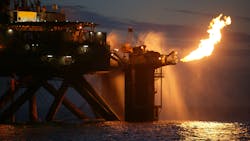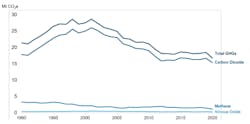NSTA report confirms steady drop in UK North Sea emissions
Offshore staff
LONDON — Britain’s North Sea oil and gas industry is meeting early emissions reduction targets after achieving cuts of more than a one-fifth between 2018 to 2021.
The latest Emissions Monitoring Report from the North Sea Transition Authority (NSTA) shows greenhouse-gas (GHG) emissions in the UK offshore sector down by an estimated 14.6% to 14.3 MM metric tons of CO2e last year, with an overall reduction of 21.5% since 2018.
The industry has been investing in more energy-efficient equipment and technologies that minimize flaring. Other factors in the improvement have been a reduction in offshore activity during the main period of the COVID-19 pandemic and the permanent shutdown of several platforms with high emissions in recent years.
And platform maintenance shutdowns, timed to coincide with temporary pipeline closures, contributed to the drop in production and associated emissions last year.
NSTA projections suggest the sector is on course to meet interim emissions reduction targets of 10% by 2025 and 25% by 2027, both agreed in last year’s North Sea Transition Deal between the sector and the UK government.
But the 2030 goal of halving emissions will require upgrades of platforms to run on clean electricity, instead of gas or diesel. The NSTA expects at least two UK offshore electrification projects to be commissioned by 2027.
In the first half of 2021, the NSTA began requesting licensees to implement emissions reduction plans for new and existing projects and introduced strict guidance to control flaring, the source of more than one-fifth of UK Continental Shelf emissions, and venting.
These actions, it said, have led to installation of equipment powered by electricity, instead of gas, and systems that capture gas, which would otherwise have been flared—helping to drive down offshore flared volumes by 20% in 2021 and venting by 22%.
9/21/2022

